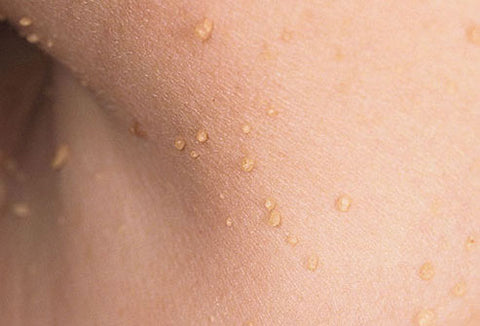

So, if you notice these small benign growths pop up easily on your skin, take extra precautions in the sun to prevent more from forming. Some people are predisposed to develop moles, and sun exposure stimulates them. Because of their pigment, they have the rare potential to change from a regular mole into skin cancer. Warts don’t have either, but moles have both.

To see a visual difference between wart and mole bumps, look for pigment and hair. If they become cancerous, they begin to change. They form slowly, taking a long time to grow. Moles are the most serious of these three skin issues. They often appear on the hands, feet, elbows, and knees - where the skin is thicker and grows more slowly. Warts, however, appear as rough skin, possibly with points on the surface. Moles typically appear in sun-exposed areas such as the arms, face, back, and chest and are not contagious.īoth warts and moles have a broad base and go deep into the skin, but on a mole, the skin remains soft. These dark spots grow slowly and don’t change much, but they can grow hair. While warts are colorless, moles are brown. Identifying a mole vs wart is also relatively easy. This kills the cells containing the virus so your skin can heal wart-free. So they stop the treatment too soon for it to be effective.įor the fastest wart treatment, ask your dermatologist to freeze the wart. They realize they don’t know what they’re doing, and they can’t stand the pain. If people start an over-the-counter treatment, they often second-guess themselves when the area starts to hurt. So you have to treat it long enough to kill all the skin cells that contain the virus. If you don’t get rid of the virus, you won’t get rid of the wart. Why? They’re a virus that lives in the skin cells. But when people try to treat them at home, they never seem to get better. Should You Have A Wart Removed?Īlthough we recommend removing any of these spots, warts especially need to be removed quickly (before you pass the virus along to someone else). So, when you see a wart pop up, that means you came into contact with someone else with a wart virus, whether through shaking hands or using the same hand towel. And like all viruses, they’re contagious. Although they may be smooth on top, they’re thick, scaly, and callus-like underneath. Unlike moles, they’re hard bumps that lie deep in the skin. Warts pop up on your hands, knees, or the bottom of your feet. Skin tags are not contagious to you or anyone else. It can spread to other people, or to other parts of your body. Most importantly, a wart is caused by a virus and is contagious. Warts are thick and deep, while skin tags remain at the surface. Like skin tags, warts are typically colorless, unless the skin where it’s formed has a color distinction. Neither of these spots have hair growing from them.
CANCEROUS SKIN TAGS PICTURES PATCH
A rough, broad-based patch of thick skin is likely a wart. A colorless raised flap of skin that looks like a little balloon on a stick is a skin tag. Wartĭistinguishing a skin tag vs wart is rather simple. In general, they are just bothersome.Īlthough they are not dangerous, when skin tags become painful, tender, or unsightly, many patients ask to get them removed. The biggest problem with skin tags is the irritation they cause. Because of friction, the flap rises even more and can form into a ball shape. That bump is then rubbed, typically under the arms, in the groin, or around the neck. They form when a small bump or gland sticks up from the skin. Skin tags are small flaps of skin, ranging from the size of a small pen head to three centimeters. You end up with a ball of skin attached by a thin pedestal. The little ball of skin cells gets pulled up further and further until it’s hanging by a thread. Then, once it starts rubbing, there’s a snowball effect.

It starts as a small bump or gland in the skin. It’s been rubbed by a collar, clothing, or sometimes it comes from skin rubbing against skin, particularly under the arm. This little flap of skin forms because of friction.
CANCEROUS SKIN TAGS PICTURES HOW TO
So, if you want to know what you’re dealing with before you schedule a spot removal, here’s how to tell the difference between a mole, a wart, and a skin tag. But they’re annoying, and it makes your life more comfortable to get rid of them before they become a problem. The good news: none of them cause a risk to your health. Most people just don’t know the difference between them. Let’s face it: moles, skin tags, and warts are irritating.


 0 kommentar(er)
0 kommentar(er)
